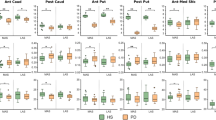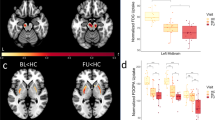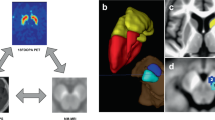Abstract
Object
In the present study, we aimed to evaluate the impact of neurodegeneration of the nigrostriatal tract in a rodent model of Parkinson’s disease on the different MR contrasts (T2, T1, CBF and CBV) measured in the striatum.
Material and methods
Animals were injected with 6-hydroxydopamine (6OHDA) in the substantia nigra resulting in massive loss of nigrostriatal neurons and hence dopamine depletion in the ipsilateral striatum. Using 7T MRI imaging, we have quantified T2, T1, CBF and CBV in the striata of 6OHDA and control rats. To validate the lesion size, behavioral testing, dopamine transporter μSPECT and tyrosine hydroxylase staining were performed.
Results
No significant differences were demonstrated in the absolute MRI values between 6OHDA animals and controls; however, 6OHDA animals showed significant striatal asymmetry for all MRI parameters in contrast to controls.
Conclusions
These PD-related asymmetry ratios might be the result of counteracting changes in both intact and affected striatum and allowed us to diagnose PD lesions. As lateralization is known to occur also in PD patients and might be expected in transgenic PD models as well, we propose that MR-derived asymmetry ratios in the striatum might be a useful tool for in vivo phenotyping of animal models of PD.
Similar content being viewed by others
Abbreviations
- 6OHDA:
-
6-Hydroxydopamine
- CBF:
-
Cerebral blood flow
- CBV:
-
Cerebral blood volume
- DA:
-
Dopamine
- DAT:
-
Dopamine transporter
- FOV:
-
Field of view
- PD:
-
Parkinson’s disease
- ROI:
-
Region of interest
- SN:
-
Substantia nigra
- VOI:
-
Volume of interest
References
Burns RS, Chiueh CC, Markey SP, Ebert MH, Jacobowitz DM, Kopin IJ (1983) A primate model of parkinsonism: selective destruction of dopaminergic neurons in the pars compacta of the substantia nigra by N-methyl-4-phenyl-1,2,3,6-tetrahydropyridine. Proc Natl Acad Sci USA 80(14): 4546–4550
Mendez JS, Finn BW (1975) Use of 6-hydroxydopamine to create lesions in catecholamine neurons in rats. J Neurosurg 42(2): 166–173
Schwarting R, Huston J (1996) Unilateral 6-hydroxydopamine lesions of meso-striatal dopamine neurons and their physiological sequelae. Prog Neurobiol 49(3): 215–266
Huang Y, Cheung L, Rowe D, Halliday G (2004) Genetic contributions to Parkinson’s disease. Brain Res Brain Res Rev 46(1): 44–70
Lauwers E, Beque D, Van Laere K, Nuyts J, Bormans G, Mortelmans L, Casteels C, Vercammen L, Bockstael O, Nuttin B, Debyser Z, Baekelandt V (2006) Non-invasive imaging of neuropathology in a rat model of alpha-synuclein overexpression. Neurobiol Aging 28(2): 248–257
Lauwers E, Debyser Z, Van Dorpe J, De Strooper B, Nuttin B, Baekelandt V (2003) Neuropathology and neurodegeneration in rodent brain induced by lentiviral vector-mediated overexpression of alpha-synuclein. Brain Pathol 13(3): 364–372
Baekelandt V, Claeys A, Eggermont K, Lauwers E, De Strooper B, Nuttin B, Debyser Z (2002) Characterization of lentiviral vector-mediated gene transfer in adult mouse brain. Hum Gene Ther 13(7): 841–853
Lo BC, Schneider BL, Bauer M, Sajadi A, Brice A, Iwatsubo T, Aebischer P (2004) Lentiviral vector delivery of parkin prevents dopaminergic degeneration in an alpha-synuclein rat model of Parkinson’s disease. Proc Natl Acad Sci USA 101(50): 17510–17515
Lo BC, Ridet JL, Schneider BL, Deglon N, Aebischer P (2002) alpha-Synucleinopathy and selective dopaminergic neuron loss in a rat lentiviral-based model of Parkinson’s disease. Proc Natl Acad Sci USA 99(16): 10813–10818
Boska MD, Hasan KM, Kibuule D, Banerjee R, McIntyre E, Nelson JA, Hahn T, Gendelman HE, Mosley RL (2007) Quantitative diffusion tensor imaging detects dopaminergic neuronal degeneration in a murine model of Parkinson’s disease. Neurobiol Dis 26(3): 590–596
Kondoh T, Bannai M, Nishino H, Torii K (2005) 6-Hydroxydopamine-induced lesions in a rat model of hemi-Parkinson’s disease monitored by magnetic resonance imaging. Exp Neurol 192(1): 194–202
Pelled G, Bergman H, Goelman G (2002) Bilateral overactivation of the sensorimotor cortex in the unilateral rodent model of Parkinson’s disease—a functional magnetic resonance imaging study. Eur J Neurosci 15(2): 389–394
Pelled G, Bergman H, Ben-Hur T, Goelman G (2005) Reduced basal activity and increased functional homogeneity in sensorimotor and striatum of a Parkinson’s disease rat model: a functional MRI study. Eur J Neurosci 21(8): 2227–2232
Pelled G, Bergman H, Ben-Hur T, Goelman G (2007) Manganese-enhanced MRI in a rat model of Parkinson’s disease. J Magn Reson Imaging 26(4): 863–870
Schwarting R, Huston J (1996) The unilateral 6-hydroxydopamine lesion model in behavioral brain research. Analysis of functional deficits, recovery and treatments. Prog Neurobiol 50(2–3): 275–331
Fischman AJ, Babich JW, Elmaleh DR, Barrow SA, Meltzer P, Hanson RN, Madras BK (1997) SPECT imaging of dopamine transporter sites in normal and MPTP-treated rhesus monkeys. J Nucl Med 38(1): 144–150
Booij J, Andringa G, Rijks LJ, Vermeulen RJ, De Bruin K, Boer GJ, Janssen AG, Van Royen EA (1997) 123I]FP-CIT binds to the dopamine transporter as assessed by biodistribution studies in rats and SPECT studies in MPTP-lesioned monkeys. Synapse 27(3): 183–190
Scherfler C, Donnemiller E, Schocke M, Dierkes K, Decristoforo C, Oberladstatter M, Kolbitsch C, Zschiegner F, Riccabona G, Poewe W (2002) Evaluation of striatal dopamine transporter function in rats by in vivo beta-[123I]CIT pinhole SPECT. NeuroImage 17(1): 128–141
Meissner W, Prunier C, Guilloteau D, Chalon S, Gross CE, Bezard E (2003) Time-course of nigrostriatal degeneration in a progressive MPTP-lesioned macaque model of Parkinson’s disease. Mol Neurobiol 28(3): 209–218
Perese DA, Ulman J, Viola J, Ewing SE, Bankiewicz KS (1989) A 6-hydroxydopamine-induced selective parkinsonian rat model. Brain Res 494(2): 285–293
Thomas J, Wang J, Takubo H, Sheng J, de Jesus S, Bankiewicz KS (1994) A 6-hydroxydopamine-induced selective Parkinsonian rat model: further biochemical and behavioral characterization. Exp Neurol 126(2): 159–167
Perese DA, Ulman J, Viola J, Ewing SE, Bankiewicz KS (1989) A 6-hydroxydopamine-induced selective parkinsonian rat model. Brain Res 494(2): 285–293
Ungerstedt U (1971) Striatal dopamine release after amphetamine or nerve degeneration revealed by rotational behaviour. Acta Physiol Scand 367: 49–68
Votaw J, Byas-Smith M, Hua J, Voll R, Martarello L, Levey AI, Bowman FD, Goodman M (2003) Interaction of isoflurane with the dopamine transporter. Anesthesiology 98(2): 404–411
Votaw JR, Byas-Smith MG, Voll R, Halkar R, Goodman MM (2004) Isoflurane alters the amount of dopamine transporter expressed on the plasma membrane in humans. Anesthesiology 101(5): 1128–1135
Bequé D, Vanhove C, Andreyev A, Nuyts J, Defrise M (2004) Correction for imperfect camera motion and resolution recovery in pinhole SPECT. Conference proceedings of IEEE medical imaging conference, Rome, Italy M2-173
Bequé D, Nuyts J, Suetens P, Bormans P (2005) Optimization of geometrical calibration in pinhole SPECT. IEEE Trans Med Imaging 24(5): 667–675
Casteels C, Vermaelen P, Nuyts J, Van Der LA, Baekelandt V, Mortelmans L, Bormans G, Van LK (2006) Construction and evaluation of multitracer small-animal PET probabilistic atlases for voxel-based functional mapping of the rat brain. J Nucl Med 47(11): 1858–1866
Hall S, Rutledge JN, Schallert T (1992) MRI, brain iron and experimental Parkinson’s disease. J Neurol Sci 113(2): 198–1208
Kondoh T, Bannai M, Nishino H, Torii K (2005) 6-Hydroxydopamine-induced lesions in a rat model of hemi-Parkinson’s disease monitored by magnetic resonance imaging. Exp Neurol 192(1): 194–202
Casteels C, Lauwers E, Bormans G, Baekelandt V, Van LK (2008) Metabolic-dopaminergic mapping of the 6-hydroxydopamine rat model for Parkinson’s disease. Eur J Nucl Med Mol Imaging 35(1): 124–134
Araujo DM, Cherry SR, Tatsukawa KJ, Toyokuni T, Kornblum HI (2000) Deficits in striatal dopamine D(2) receptors and energy metabolism detected by in vivo microPET imaging in a rat model of Huntington’s disease. Exp Neurol 166(2): 287–297
Booij J, Bruin K, de Win MML, Lavini C, den Heeten GJ, Habraken JBA (2003) Imaging of striatal dopamine transporters in rat brain with single pinhole SPECT and co-aligned MRI is highly reproducible. Nucl Med Biol 30(6): 643–649
Baete K, Nuyts J, Laere KV, Van Paesschen W, Ceyssens S, De Ceuninck L, Gheysens O, Kelles A, Vanden Eynden J, Suetens P, Dupont P (2004) Evaluation of anatomy based reconstruction for partial volume correction in brain FDG-PET. NeuroImage 23(1): 305–317
Kosta P, Argyropoulou MI, Markoula S, Konitsiotis S (2006) MRI evaluation of the basal ganglia size and iron content in patients with Parkinson’s disease. J Neurol 253(1): 26–32
Vymazal J, Righini A, Brooks R, Canesi M, Mariani C, Leonardi M, Pezzoli G (1999) T1 and T2 in the brain of healthy subjects, patients with Parkinson disease, and patients with multiple system atrophy: relation to iron content. Radiology 211(2): 489–495
Ye F, Allen P, Martin W (1996) Basal ganglia iron content in Parkinson’s disease measured with magnetic resonance. Mov Disord 11(3): 243–249
Brex PA, Parker GJ, Leary SM, Molyneux PD, Barker GJ, Davie CA, Thompson AJ, Miller DH (2000) Lesion heterogeneity in multiple sclerosis: a study of the relations between appearances on T1 weighted images, T1 relaxation times, and metabolite concentrations. J Neurol Neurosurg Psychiatry 68(5): 627–632
Paxinos G (1995) The rat nervous system. 2 edn. Academic Press, California
Hsu JL, Jung TP, Hsu CY, Hsu WC, Chen YK, Duann JR, Wang HC, Makeig S (2007) Regional CBF changes in Parkinson’s disease: a correlation with motor dysfunction. Eur J Nucl Med Mol Imaging 34(9): 1458–1466
Yang J, Sadler TR, Givrad TK, Maarek JM, Holschneider DP (2007) Changes in brain functional activation during resting and locomotor states after unilateral nigrostriatal damage in rats. NeuroImage 36(3): 755–773
Bezard E, Gross CE, Brotchie JM (2003) Presymptomatic compensation in Parkinson’s disease is not dopamine-mediated. Trends Neurosci 26(4): 215–221
Dahlgren N, Lindvall O, Nobin A, Stenevi U (1981) Cerebral circulatory response to hypercapnia: effects of lesions of central dopaminergic and serotoninergic neuron systems. Brain Res 230(1–2): 221–233
Lindvall O, Ingvar M, Stenevi U (1981) Effects of methamphetamine on blood flow in the caudate-putamen after lesions of the nigrostriatal dopaminergic bundle in the rat. Brain Res 211(1): 211–216
Mraovitch S, Calando Y, Onteniente B, Peschanski M, Seylaz J (1993) Cerebrovascular and metabolic uncoupling in the caudate-putamen following unilateral lesion of the mesencephalic dopaminergic neurons in the rat. Neurosci Lett 157(2): 140–144
Choi JK, Chen YI, Hamel E, Jenkins BG (2006) Brain hemodynamic changes mediated by dopamine receptors: Role of the cerebral microvasculature in dopamine-mediated neurovascular coupling. NeuroImage 30(3): 700–712
Author information
Authors and Affiliations
Corresponding author
Rights and permissions
About this article
Cite this article
Van Camp, N., Vreys, R., Van Laere, K. et al. Morphologic and functional changes in the unilateral 6-hydroxydopamine lesion rat model for Parkinson’s disease discerned with μSPECT and quantitative MRI. Magn Reson Mater Phy 23, 65–75 (2010). https://doi.org/10.1007/s10334-010-0198-7
Received:
Revised:
Accepted:
Published:
Issue Date:
DOI: https://doi.org/10.1007/s10334-010-0198-7




